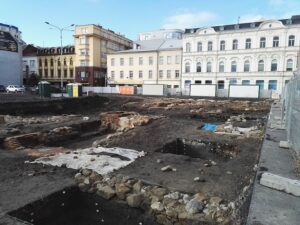 dav
dav New York City is often seen as a modern metropolis of steel and glass, towering above the hustle of millions of people. But beneath its concrete streets and behind the walls of its brownstones lies another story—one that begins centuries before the Empire State Building touched the sky. This hidden history is being unearthed, piece by piece, through the science of archaeology, and it has a profound impact on how renovation and construction projects are carried out in the city today.
Welcome to the fascinating intersection of archaeology and urban renovation—a complex dance between preservation and progress, between the shovel and the scaffold.
The Hidden Layers of New York City
New York City is built on layers—not just layers of infrastructure or bureaucracy, but actual historical strata. Every time a foundation is dug or a wall is torn down, there’s a chance of uncovering relics from centuries past. From colonial settlements to Native American encampments, from Dutch traders to early African American communities, the city’s soil holds secrets that must be respected and protected.
This deeply layered history means that developers and renovators are not just dealing with bricks and mortar—they’re dealing with heritage.
Archaeology’s Role in Urban Development
In many cities around the world, archaeology is closely tied to urban planning and development. NYC is no different. The Landmarks Preservation Commission (LPC), established in 1965, oversees archaeological matters in the city, particularly in designated Historic Districts or areas suspected of holding archaeological significance.
When a construction or renovation project is proposed, especially in older parts of the city like Lower Manhattan, the Financial District, Brooklyn Heights, or Harlem, developers may be required to conduct an archaeological review. This review ensures that potential historical resources are not destroyed without documentation or consideration.
Regulatory Framework: Renovation Rules Grounded in Archaeology
The rules that govern renovation in NYC are heavily influenced by archaeological concerns, especially in sensitive areas. Here’s how the process typically works:
1. Phase IA Archaeological Assessment
Before any ground is broken, an environmental or historical consultant may conduct a Phase IA study. This involves researching the historical significance of the site, reviewing old maps, deeds, and documents to determine whether archaeological artifacts might be present.
2. Phase IB Testing
If Phase IA suggests the potential for buried resources, a Phase IB investigation is initiated. This stage involves actual digging—test pits, core samples, or soil boring—to physically check for artifacts.
3. Phase II Site Evaluation
If significant materials are found, a Phase II study may be required. This involves broader excavation and documentation of findings. Depending on the nature of the artifacts, this could delay the project for weeks or even months.
4. Phase III Data Recovery
In rare cases where the findings are exceptionally significant, full-scale excavation (Phase III) is conducted before construction can resume. This is the most time-consuming and expensive phase.
Not Just a Legal Hurdle—A Moral and Cultural Responsibility
While some developers see archaeological reviews as an obstacle, many recognize the importance of preserving the city’s heritage. Every artifact tells a story—of the city’s first immigrants, of industries that no longer exist, of communities that were displaced or forgotten.
There have been extraordinary discoveries during renovation and construction, such as:
- The African Burial Ground: Discovered in the 1990s during construction for a federal office building, this site in Lower Manhattan revealed over 400 skeletal remains of African slaves buried in the 17th and 18th centuries. Today, it is a National Monument and a sobering reminder of the city’s past.
- The Stadt Huys Block: Excavations in Lower Manhattan unearthed remnants of the city’s first city hall, dating back to the 17th century Dutch colonial period. Renovation projects in the area are now tightly controlled to avoid disturbing what’s left.
- Colonial-Era Taverns and Homes: During utility or renovation work in neighborhoods like the South Street Seaport or Wall Street, teams have found the foundations of colonial homes, taverns, and even pottery and tools.
Each of these discoveries has influenced how future renovations are planned and executed.
How Renovators Navigate Archaeological Constraints
Renovating or restoring a building in New York, particularly one that’s landmarked or historically located, often requires navigating a complex web of permits and approvals.
Some key steps that responsible renovation contractors take include:
Pre-Construction Research
Before bidding on a project, experienced contractors often do their own historical research to assess potential risks. Knowing the past of a location can help in cost estimation and project timelines.
Working with Preservationists and Archaeologists
Contractors frequently collaborate with professionals trained in archaeology and historic preservation. This ensures that any findings are handled properly and in compliance with city regulations.
Adapting Design Plans
Sometimes the design or layout of a renovation must be altered to accommodate archaeological preservation. For example, an underground parking garage might be relocated to avoid disturbing historical foundations.
Training and Awareness
Construction crews are trained to recognize potential artifacts or soil changes that could indicate buried structures or objects. If anything is found, work is paused, and experts are brought in.
Economic and Cultural Impact of Archaeology on Renovation
It’s easy to assume that all these rules just add cost and delay. But there are long-term benefits—economic, cultural, and even reputational.
Economic Value
Buildings or sites with documented historical significance often appreciate in value. They can attract tourism, commercial interest, or funding from preservation societies and grants.
Cultural Identity
Archaeology helps preserve the stories of marginalized communities that might otherwise be forgotten. Renovating with respect to these histories helps neighborhoods retain their cultural identity.
Reputation
Renovation firms known for respecting historical processes often enjoy better reputations and greater trust among government agencies and historical societies.
Case Study: Renovation at the South Street Seaport
A real-world example of archaeology influencing renovation is at the South Street Seaport Historic District. Developers planning upgrades to the 19th-century warehouse buildings had to conduct archaeological testing due to the area’s significance as a port since the 1600s.
Archaeologists found remnants of piers, goods storage, and even whalebone fragments used in early commerce. The developers adjusted their plans to preserve the foundations and incorporated archaeological displays into the final design, blending history with modernization.
The Future of Renovation in NYC: A Partnership with the Past
As the city continues to evolve, the role of archaeology in renovation is only growing. Technology like ground-penetrating radar, 3D scanning, and AI-enhanced mapping tools are making it easier to identify and protect hidden historical elements.
Meanwhile, a greater awareness of social justice and cultural preservation is leading to more inclusive archaeological practices. Projects are increasingly evaluated not just for colonial or commercial artifacts but for traces of immigrant, African-American, Indigenous, and working-class lives.
This shift is ensuring that the narrative of NYC’s past is as diverse and rich as its present.
Conclusion: Building on History, Not Over It
New York City’s skyline is constantly evolving, but its foundations are deep—rooted in the lives of countless people who came before us. By embracing archaeology as a partner rather than a problem, renovation projects can achieve something far more meaningful than just new floors or façades—they can become bridges between past and present.
For property owners and developers, this means choosing contractors who understand not just how to build, but how to preserve. Whether you’re restoring a Brooklyn brownstone or modernizing a downtown loft, working with experts who respect the past ensures a future built on integrity.
If you’re seeking professionals who blend expert craftsmanship with historical sensitivity, consider working with the best exterior renovation contractors in NYC. They’ll help you build not just walls, but legacy.
___________________________
Cover Image, Top Left: Qasinka, CC0 1.0 Universal, Wikimedia Commons




